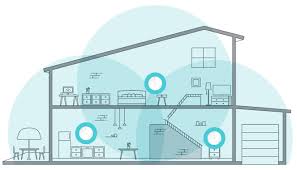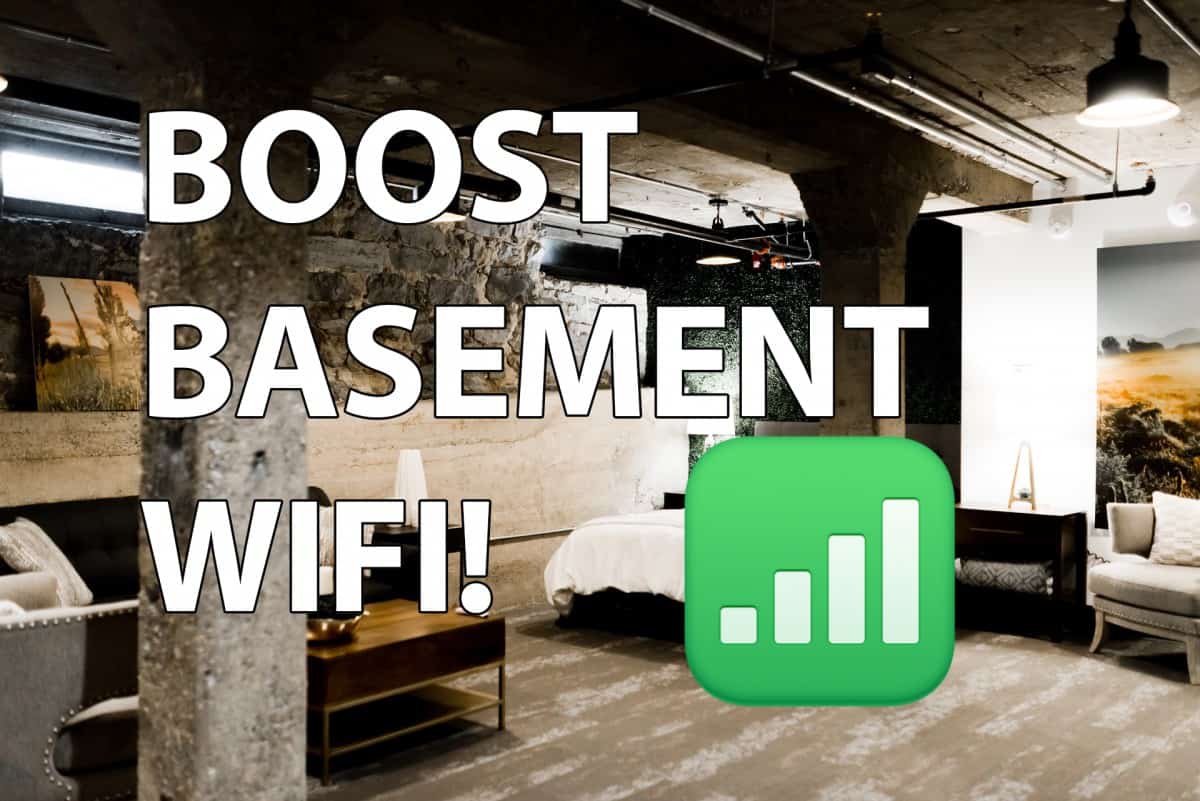Basements are enclosed spaces and sometimes this makes us think that WiFi will not work in these places.
But there are actually effective ways to make sure that your basement is always equipped with a strong WiFi connection.
You can let your WiFi work in your basements through various methods such as using powerline adapters, creating access points, using a wireless mesh system, and utilizing WiFi boosters.
This article contains methods that you can use to make the internet accessible from your basement.
But how exactly do you go about setting up all these things? Don’t worry we’ll answer these questions and more…
Ensuring Wifi Connectivity In Your Basement
If you have a wifi router at home and cannot seem to connect to it when staying in your basement, then you should check out these methods. Here are solutions that you can apply to establish a strong wifi connection.
Use a Powerline Local Area Network

Just as its name suggests, a powerline network system relies on the wirings that bring power to your house. This method requires the use of powerline adapters that must be plugged into your outlets.
This makes it convenient for you since basements usually have at least one outlet. However, a powerline local area network will only work if the adapters are plugged in on outlets connected to the same circuit.
Through this method, you can effectively maximize your WiFi connectivity by just using your home’s electrical wiring behind the walls.
The WiFi signal from your router will be distributed to your basement through the powerline adapters connected to your wirings so the adapters must be running on the same circuit.
To confirm this, you need to check if the wirings are connected in the same breaker.
Let’s say your router is on the first floor of your house but the WiFi cannot reach your basement.
A powerline adapter can be connected to your router through ethernet cables and then plugged in on an outlet on the first floor. Then, another powerline adapter will be plugged in on an outlet in your basement.
This adapter can be connected to a device that needs WiFi, like smart television, using an ethernet cable.
Or you can connect the second powerline adapter to another router or access point using an ethernet cable to let more than one device gain access to the internet wirelessly.
Remember that this will only work if the powerline adapter plugged upstairs is running on the same circuit as the powerline adapter plugged into the basement’s outlet.
If your basement’s wirings are not on the same circuit, then try to reconfigure the wires in the breaker if you can.
Physical interference from the basement to your router will not be a problem because your connectivity will be dependent on wires, but your wirings must not be outdated.
If your house wirings are old such that fuses are used instead of breakers, then this method might not be a good option.
Create Multiple Access Points For Your WiFi

Do not worry if the powerline LAN method did not work for you because there are alternative methods that you can use to ensure WiFi connectivity in your basement.
Creating multiple access points is similar to using power lines but for this method, you will solely rely on ethernet cables instead of including electrical wirings.
This method could be a bit more difficult than the previous one because you must consider the placement of the ethernet cables.
And you might even be required to use long lengths of cables especially if you’ll be creating an access point located in your basement.
But this method provides more reliable WiFi connectivity than a powerline LAN because it is free from possible electrical interferences.
An access point is a device that projects a WiFi signal after being connected to a wifi router or hub.
To make your WiFi work in the basement using this method, you will need to set up an access point in your basement and connect the access point to your existing router using ethernet cables.
When using ethernet cables, make sure to use lengths less than 328 ft because wireless network performance might degrade for longer lengths.
If your basement space is huge, it will be better to use multiple access points and to use a controller to manage all of your access points. An access point controller helps you pick the correct channels for your access points.
In case you didn’t know yet, channels of access points must not overlap with each other, or else, it can interfere with your connection to the internet.
Despite having multiple access points, you will not experience any network interruptions when moving from one access point to another.
Try A Wireless Mesh System

Unlike the first two proposed solutions, this method is completely wireless. A wireless mesh system is composed of several units.
Its system makes use of one unit that acts as the main access point and then connects to its other units that act as satellite nodes to provide wider WiFi coverage.
Despite having multiple units, the system only utilizes a single wireless network which means that connecting to any unit will indicate the same network name on your device. It is almost as if you are using multiple routers but they all share a single WiFi network.
Unlike the regular routers that provide limited coverage, a WiFi Mesh system can provide a connection to your entire house even up to the basement.
This is because each satellite node has multiple purposes – it can serve as a router, wifi extender, access point, and even a bridge.
You just need to be strategic on their placement and prioritize areas that normally have weak signals and slow WiFi speeds like basements.
If you suddenly find a new dead spot in your basement that you want to be connected to the internet, you can just buy a new satellite node and plug it in an outlet near the space.
This method is very effective in enhancing WiFi connectivity in houses with thick walls and lots of floors so for large basement areas or a two-level basement, this is an ideal solution. Another advantage of mesh systems is that it is very suitable for smart home technologies.
You can also opt to choose this method if you also want to connect all your smart home devices, even those in the basement, to a single WiFi network.
Connecting your smart devices to a single WiFi network makes it easier to manage and interact with each other.
However, this is the most expensive method on this list. If you’re saving up money, you might want to consider other options.
Use A WiFi Booster: Either A Repeater Or Extender
The last method that I can suggest is using a WiFi booster. A WiFi booster pertains to a device that can be connected to your router, either wirelessly or using ethernet cables, and can extend or rebroadcast an existing WiFi network. Examples of WiFi boosters are repeaters and extenders.
WiFi repeaters and extenders are almost similar devices that can improve WiFi coverage.
An extender does not create a new network and does not affect the existing network’s bandwidth output.
On the other hand, a repeater creates a new network that has a reduced bandwidth than your initial network.
When using both of these, they should not be placed on an actual dead spot because they must be within the router’s WiFi coverage in order to work.
A WiFi repeater or extender works by plugging it in an outlet within the reach of your existing router’s signal and then, registering the WiFi booster to your existing router using a desktop browser or through ethernet cables.
After this, the WiFi booster will provide connectivity to an area that was previously out of reach by an existing router like your basement.
This method is probably the easiest to set up but it has its drawbacks. Users of wifi boosters can experience lots of speed loss so it is advisable to be utilized on small houses or basement areas.
Factors Affecting Wifi Connectivity In Your Basement
So you’ve finally established a WiFi connection in your basement through one of the previously mentioned methods, but then you suddenly find yourself struggling to have proper connectivity at certain parts of your basement.
There will always be factors that can affect your WiFi transmission so be mindful of these when setting up WiFi connection in your basement.
Ideal Positioning Of The Router
If you are using WiFi boosters, the positioning of the router must ensure that the booster will receive a strong wifi signal all the time.
If you are using access points and mesh systems, it is best to be strategic about the position of the router such that the access points cover all the dead spots that the router cannot reach.
For houses with multiple floors and basement levels, place the router on the floor of the first floor to create even signal distribution below and above the house.
Objects That Can Be Blocking Your Signal

The radio waves used by WiFi can be blocked by solid walls, such as concrete and thick timber, and metallic objects. Try to avoid creating thick interior walls in your basement to maximize connectivity anywhere.
Also, make sure that the source of your wifi signal in the basement is not surrounded by metallic objects or not placed inside a metallic cabinet.
Thick leaves and trees can also block signal so if you have ornamental designs, better place them on the sides or the corners of the basement.
For basements with multiple levels, take note that the floor heating mechanism can also block wifi signals.
Amount Of Bandwidth Usage
Bandwidth is the amount of data being transmitted by your WiFi. As the number of devices connected increases, the need for bandwidth also increases which can affect the network’s speed.
To ensure better WiFi connectivity in the basement, refrain from using large amounts of data when you are in the basement like downloading large files.
You can also assign a bandwidth quota for each WiFi user in your basement to regulate your bandwidth.
Electromagnetic And Electronic Interferences
Electronic equipment or any equipment emitting electromagnetic waves, like microwave ovens, can interfere with your wifi connectivity as well as cables with large voltage.
Bluetooth devices can also interfere with WiFi signals and may cause unnecessary automatic switching of WiFi channels.
If you are using a wireless method for WiFi connectivity in your basement, move these types of equipment the farthest it can be from your WiFi signal source such that their interferences are minimized.
Advancement In WiFi Technologies
Our devices that are usually connected to the WiFi, like smartphones and laptops, are subject to constant technological improvements.
Make sure that your WiFi technologies are not outdated to enable efficient connectivity especially in the basement.
For a better WiFi experience anywhere in your house, it is ideal to have your WiFi technologies in sync with the latest updates available to your smart gadgets.
Conclusion
A basement with a stable WiFi connection is a great feature for your home. Imagine being able to watch Netflix together with friends, stream online games, and even join video calls with your family without having to worry that you are in your basement.
Using any of the methods and taking into mind the factors that I have mentioned, you can surely have a basement that can provide WiFi connectivity all the time.
P.S.
That’s it for this article. I hope you enjoyed reading it and if you think it might be useful for someone else then please share it on social media, email or your own website! It really encourages us to write more content and grow the site!
If you’re interested in reading more about smart light, smart garages and smart homes checkout some of the other houshia categories including:

